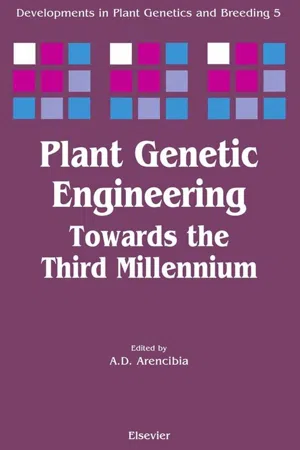
- 284 pages
- English
- ePUB (mobile friendly)
- Available on iOS & Android
About This Book
Plant biotechnology offers important opportunities for agriculture, horticulture, and the pharmaceutical and food industry by generating transgenic varieties with altered properties. This is likely to change farming practice and reduce the potential negative impact of plant production on the environment. This volume shows the worldwide advances and potential benefits of plant genetic engineering focusing on the third millennium. The authors discuss the production of transgenic plants resistant to biotic and abiotic stress, the improvement of plant qualities, the use of transgenic plants as bioreactors, and the use of plant genomics for genetic improvement and gene cloning. Unique to this book is the integrative point of view taken between plant genetic engineering and socioeconomic and environmental issues. Considerations of regulatory processes to release genetically modified plants, as well as the public acceptance of the transgenic plants are also discussed.This book will be welcomed by biotechnologists, researchers and students alike working in the biological sciences. It should also prove useful to everyone dedicated to the study of the socioeconomic and environmental impact of the new technologies, while providing recent scientific information on the progress and perspectives of the production of genetically modified plants.
The work is dedicated to Professor Marc van Montagu.
Frequently asked questions
Information
Analysis of Quantitative Trait Locis (QTL) Based on Linkage Maps in Coconut (Cocos nucifera L.)
2. PCA-Albay Research Centre, Guinobatan, Albay 4503, Philippines.
3. MPI für Züchtungsforschung, Carl-von-Linné-Weg 10, 50829 Köln, Germany.
* Author for correspondence
Introduction
Materials and Methods
Plant material
Table of contents
- Cover image
- Title page
- Table of Contents
- Copyright page
- Preface
- Global Status of Transgenic Crops: Challenges and Opportunities
- Can the Biotechnology Revolution Feed the World?
- Biotechnology Can Help Crop Production to Feed an Increasing World Population-Positive and Negative Aspects Need to be Balanced: A Perspective from FAO
- Molecular Markers in Variety and Seed Testing
- The Genetic Basis of Drought Tolerance in Maize and Options for Improvement Via Marker-Assisted Selection
- Analysis of Quantitative Trait Locis (QTL) Based on Linkage Maps in Coconut (Cocos nucifera L.)
- Molecular Characterization of the Sugarcane Variability for Genetic Improvement
- Somaclonal Variation in Transgenic Sugarcane Plants: Practical Implications
- On the Mechanism of Horizontal Gene Transfer by Agrobacterium tumefaciens
- Sugarcane (Saccharum hybrid) Genetic Transformation Mediated by Agrobacterium tumefaciens: Production of Transgenic Plants Expressing Proteins with Agronomic and Industrial Value
- Progress in Agrobacterium-mediated Maize Transformation at the Plant Transformation Facility of Iowa State University
- Assessment of Conditions Affecting Agrobacterium-mediated Soybean Transformation and Routine Recovery of Transgenic Soybean
- Genetic Engineering of Cuban Rice Cultivars: Present and Perspectives
- Histological and Ultrastructural Analysis of A. rhizogenes-mediated Root Formation in Walnut Cuttings
- Genetic Improvement Program at the Institute of Plant Biotechnology
- Sweet Potato (Ipomoea batatas L.) Regeneration and Transformation Technology to Provide Weevil (Cylas formicarius) Resistance. Field Trial Results
- Regulation of Transgene Expression: Progress Towards Practical Development in Sugarcane, and Implications for Other Plant Species
- Polycistronic Translation in Plants. What Can we Learn from Viruses
- Towards Plantibody-Mediated Resistance to Plant Parasitic Nematodes
- Field and Molecular Evaluation of Insect-Resistant Transgenic Poplar (Populus nigra L.) Trees
- Insect-resistant Tropical Plants and New Assessment About Cry Proteins
- Inserting the Nucleoprotein Gene of Tomato Spotted Wilt Virus in Different Plant Species, and Screening for Virus Resistance
- Advances in Potato Improvement Through Genetic Engineering
- Agriculture for Marginal Lands: Transgenic Plants Towards the Third Millennium
- Commercialization of Genetically Engineered Potato Plants Resistant to Disease
- Potato Transgenic Plants Expressing Mammalian Double Stranded RNA-Dependent Protein Kinase (mPKR)
- Genetic Engineering of Potato for Tolerance to Biotic and Abiotic Stress
- Metabolic Engineering of Brassica Seeds Oils: Improvement of Oil Quality and Quantity and Alteration of Carbon Flux
- Towards the Improvement of Sugarcane Bagasse as Raw Material for the Production of Paper Pulp and Animal Feed
- Strategies for Fructan Production in Transgenic Sugarcane (Saccharmu spp L.) and Sweet Potato (Ipomoea batata L.) Plants Expressing the Acetobacter diazotrophicus levansucrase
- Molecular Analysis of Plant Fructan Accumulation
- Genetic Engineering of Fruits and Vegetables with the Ethylene Control Gene Encoding S-adenosylmethionine hydrolase (SAMase)
- Improvement of Wood Quality for the Pulp and Paper Industry by Genetic Modification of Lignin Biosynthesis in Poplar
- Molecular Farming of Pharmaceutical and Veterinary Proteins from Transgenic Plants: CIGB Experience
- Toward Molecular Farming of Therapeutics in Plants
- Production of Autoantigens in Plant for Oral Immunotherapy of Autoimmune Diseases
- Safety Assessments for Commercialization of Transgenic Crops and Results of Commercialization
- Does Biotechnology Change the Research and Development Organizations?
- Biological Aspects and Ethical Considerations for the Utilization of GMOs
- Index